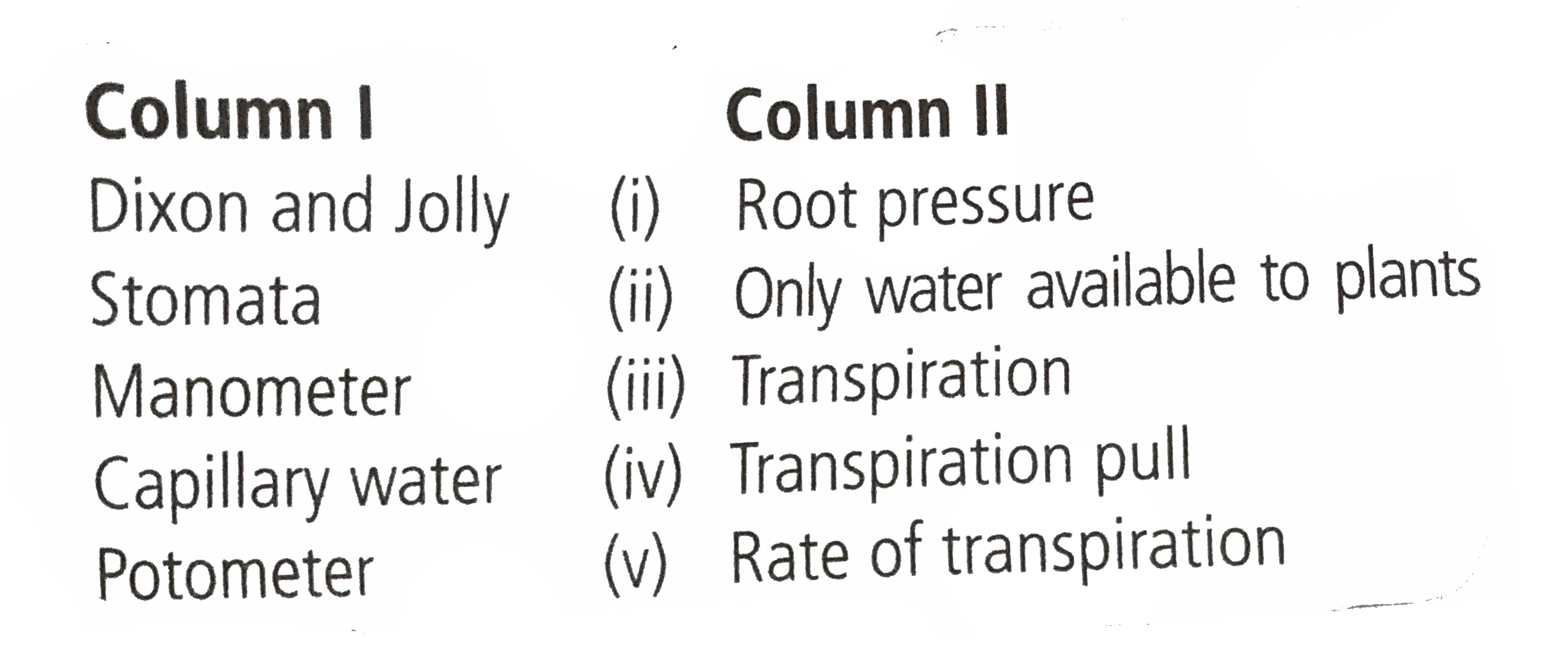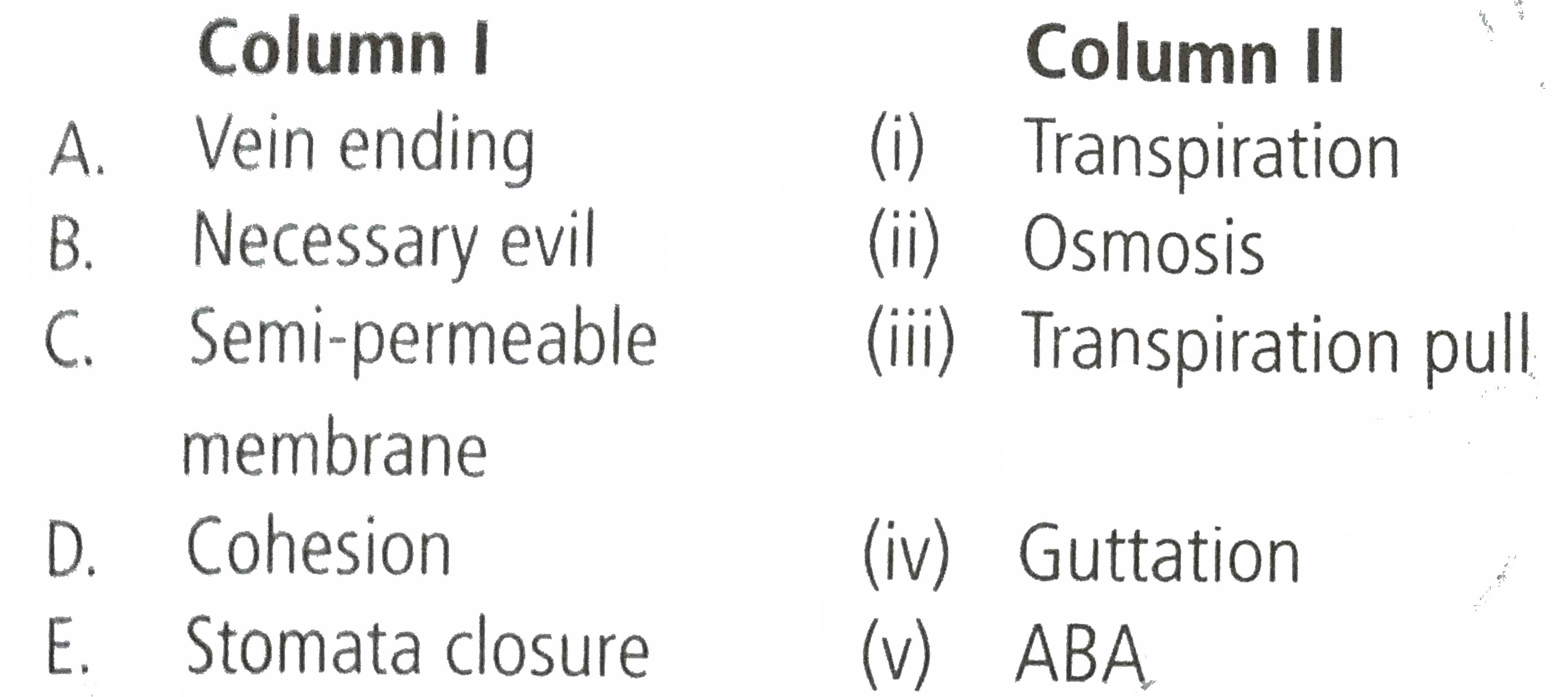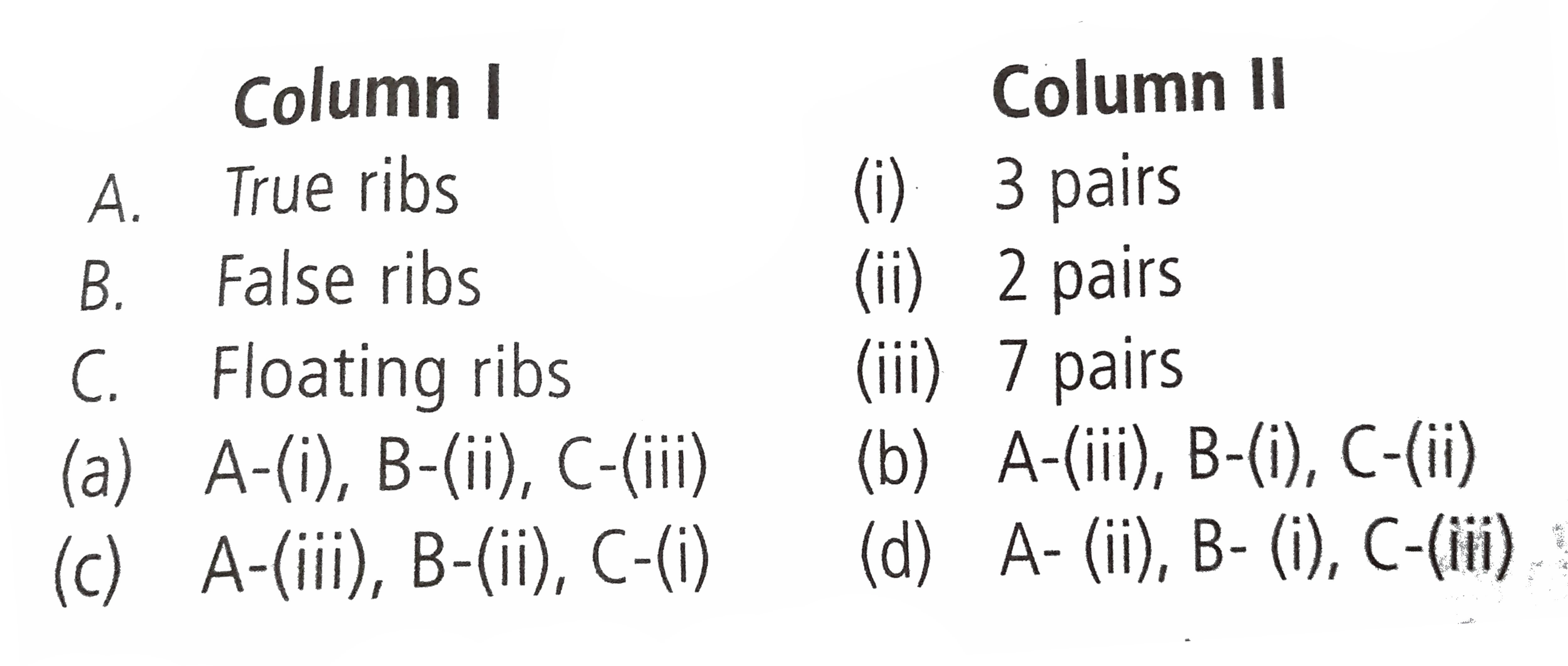Match the column I with column II and select the correct option from the given codes.
Column IColumn IIPhycomycetes(i)Sac fungiAscomycetes(ii)Algal fungiBasidiomycetes(iii)Fungi imperfectiDuteromycetes(iv)Club fungi
ii,i,iv,iii
ii,iv,i,iii
iv,i,ii,iii
iv,iii,ii,i
The correct Answer is:A
To solve the matching question, we will analyze each term in Column I and find its corresponding term in Column II based on the characteristics and classifications of fungi.
1. Identify Phycomycetes:
- Phycomycetes are known as Algal fungi. They are primarily aquatic and have a thallus-like structure.
- Match: Phycomycetes → (ii) Algal fungi
2. Identify Ascomycetes:
- Ascomycetes are referred to as Sac fungi because they produce a sac-like structure called an ascus, which contains the sexual spores.
- Match: Ascomycetes → (i) Sac fungi
3. Identify Basidiomycetes:
- Basidiomycetes are commonly known as Club fungi. This is due to their club-shaped reproductive structures called basidia, which bear the sexual spores.
- Match: Basidiomycetes → (iv) Club fungi
4. Identify Deuteromycetes:
- Deuteromycetes are also known as Fungi imperfecti. This group does not fit into the established classifications because they lack a known sexual stage.
- Match: Deuteromycetes → (iii) Fungi imperfecti
Final Matches:
- Phycomycetes → (ii) Algal fungi
- Ascomycetes → (i) Sac fungi
- Basidiomycetes → (iv) Club fungi
- Deuteromycetes → (iii) Fungi imperfecti
Summary of Matches:
- Column I:
- Phycomycetes → Algal fungi
- Ascomycetes → Sac fungi
- Basidiomycetes → Club fungi
- Deuteromycetes → Fungi imperfecti
Correct Option:
Based on the matches, the correct option is:
1. Phycomycetes - (ii) Algal fungi
2. Ascomycetes - (i) Sac fungi
3. Basidiomycetes - (iv) Club fungi
4. Deuteromycetes - (iii) Fungi imperfecti
The correct answer is Option 1.
- Phycomycetes are known as Algal fungi. They are primarily aquatic and have a thallus-like structure.
- Match: Phycomycetes → (ii) Algal fungi
- Ascomycetes are referred to as Sac fungi because they produce a sac-like structure called an ascus, which contains the sexual spores.
- Match: Ascomycetes → (i) Sac fungi
- Basidiomycetes are commonly known as Club fungi. This is due to their club-shaped reproductive structures called basidia, which bear the sexual spores.
- Match: Basidiomycetes → (iv) Club fungi
- Deuteromycetes are also known as Fungi imperfecti. This group does not fit into the established classifications because they lack a known sexual stage.
- Match: Deuteromycetes → (iii) Fungi imperfecti
- Phycomycetes → (ii) Algal fungi
- Ascomycetes → (i) Sac fungi
- Basidiomycetes → (iv) Club fungi
- Deuteromycetes → (iii) Fungi imperfecti
- Column I:
- Phycomycetes → Algal fungi
- Ascomycetes → Sac fungi
- Basidiomycetes → Club fungi
- Deuteromycetes → Fungi imperfecti
Based on the matches, the correct option is:
1. Phycomycetes - (ii) Algal fungi
2. Ascomycetes - (i) Sac fungi
3. Basidiomycetes - (iv) Club fungi
4. Deuteromycetes - (iii) Fungi imperfecti
Topper's Solved these Questions
- BOOK - NCERT FINGERTPS ENGLISHCHAPTER - BIOLOGICAL CLASSIFICATIONEXERCISE - Exemplar Problems12videos
BIOLOGICAL CLASSIFICATION
- BOOK - NCERT FINGERTPS ENGLISHCHAPTER - BIOLOGICAL CLASSIFICATIONEXERCISE - Corner15videos
BIOLOGICAL CLASSIFICATION
- BOOK - NCERT FINGERTPS ENGLISHCHAPTER - BIOLOGICAL CLASSIFICATIONEXERCISE - KINGDON PROTISTA40videos
BIOLOGICAL CLASSIFICATION
- BOOK - NCERT FINGERTPS ENGLISHCHAPTER - ANIMAL KINGDOMEXERCISE - Animal Kingdom148videos
ANIMAL KINGDOM
- BOOK - NCERT FINGERTPS ENGLISHCHAPTER - BIOMOLECULESEXERCISE - Biomolecules137videos
BIOMOLECULES
Similar Questions
Knowledge Check
- Question 1 - Select One
Match column I with column II and select the correct option from the given codes.
 AA-(i), B-(ii), C-(iii), D-(iv), E-(v), F-(vi), G-(vii)BA-(vii), B-(vi), C-(v), D-(iv), E-(iii), F-(ii), G-(i)CA-(i), B-(ii), C-(iv), D-(iii), E-(v), F-(vi), G-(vii)DA-(i), B-(ii), C-(iii), D-(iv), E-(v), F-(vii), G-(vi)
AA-(i), B-(ii), C-(iii), D-(iv), E-(v), F-(vi), G-(vii)BA-(vii), B-(vi), C-(v), D-(iv), E-(iii), F-(ii), G-(i)CA-(i), B-(ii), C-(iv), D-(iii), E-(v), F-(vi), G-(vii)DA-(i), B-(ii), C-(iii), D-(iv), E-(v), F-(vii), G-(vi) - Question 2 - Select One
Match column I with II column II and select the correct option from the given codes .
 AA-(ii), B-(iii), C-(iv), D-(i)BA-(iii), B-(ii), C-(i), D-(iv)CA-(iii), B-(ii), C-(iv), D-(i)DA-(i), B-(ii), C-(iii), D-(iv)
AA-(ii), B-(iii), C-(iv), D-(i)BA-(iii), B-(ii), C-(i), D-(iv)CA-(iii), B-(ii), C-(iv), D-(i)DA-(i), B-(ii), C-(iii), D-(iv) - Question 3 - Select One
Match columnI with column II and select the correct option from the codes given below.
 AA−(iv),B−(iii),C−(v),D−(ii),E−(i)BA−(i),B−(iii),C−(iv),D−(ii),E−(v)CA−(iv),B−(iii),C−(i),D−(ii),E−(v)DA−(v),B−(iv),C−(iii),D−(ii),E−(i)
AA−(iv),B−(iii),C−(v),D−(ii),E−(i)BA−(i),B−(iii),C−(iv),D−(ii),E−(v)CA−(iv),B−(iii),C−(i),D−(ii),E−(v)DA−(v),B−(iv),C−(iii),D−(ii),E−(i)
Match column I with column II and select the correct option from the codes given below.
 View Solution
View SolutionMatch column I with column II and select the correct option from the codes given below.
 View Solution
View SolutionMatch column I with column II and select the correct option from the codes given below.
 View Solution
View SolutionMatch column I and II and select the correct option from the given codes.
 View Solution
View SolutionMathc column I with column II and select the correct option from the given codes.
 View Solution
View Solution


